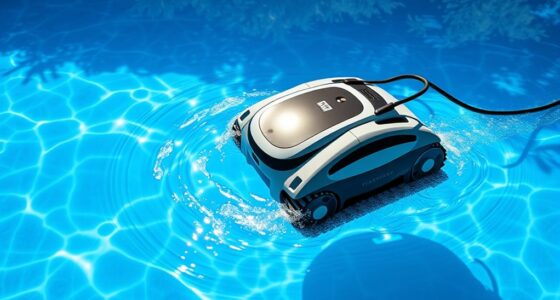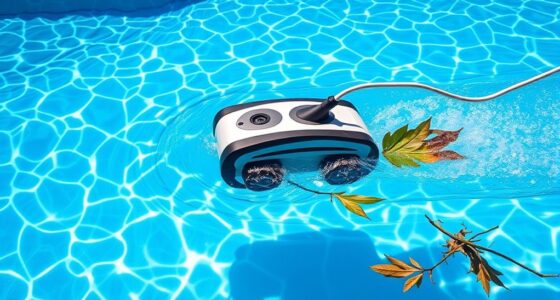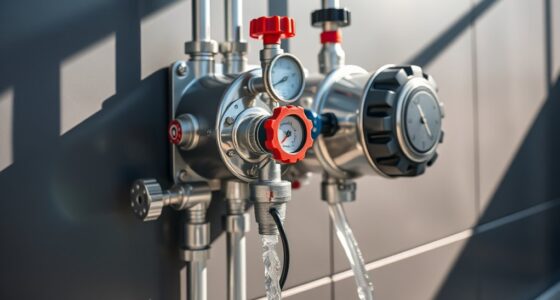Robotic pool cleaners work by autonomously maneuvering your pool using sensors, motors, and advanced algorithms to detect obstacles and map the surface. They use powerful brushes and suction to loosen and lift dirt, debris, and algae, which are then collected in filters or cartridges. You can program their schedule and modes for thorough cleaning. If you want to discover more about how these intelligent devices keep your pool sparkling, keep exploring!
Key Takeaways
- They use sensors and algorithms to map the pool layout and detect obstacles for efficient navigation.
- Powered by motors, they drive wheels or tracks to move across pool surfaces and reach all areas.
- Equipped with brushes and scrapers to loosen dirt, algae, and debris from walls and floors.
- Use internal filters or cartridges to collect debris and maintain water cleanliness.
- Employ water circulation and suction systems to remove debris and improve pool water quality.
Overview of Robotic Pool Cleaners
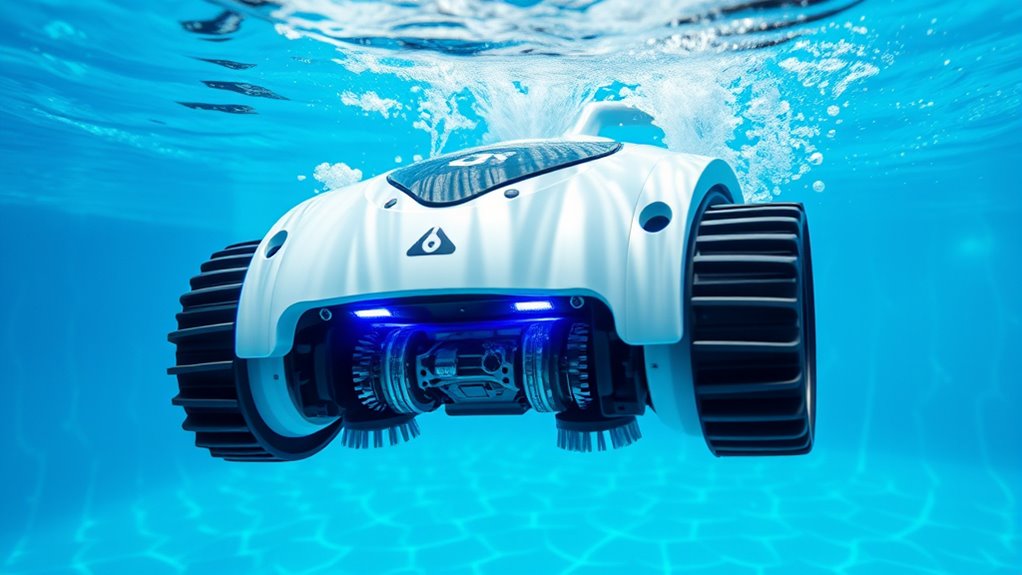
Robotic pool cleaners are automated devices designed to keep your pool spotless with minimal effort. They help maintain pool safety by preventing debris buildup that can cause slipping hazards or damage equipment. These cleaners also assist in preserving the chemical balance, as a clean pool reduces algae growth and allows chemicals to work more effectively. With smart navigation, they move around the pool’s surfaces, scrubbing floors, walls, and steps, ensuring thorough cleaning. Using sensors and timers, robotic cleaners operate efficiently, saving you time and energy. They are easy to set up and require minimal maintenance, making them a practical choice for pool owners who want a clean, safe swimming environment without the hassle of manual cleaning.
Components of a Robotic Pool Cleaner
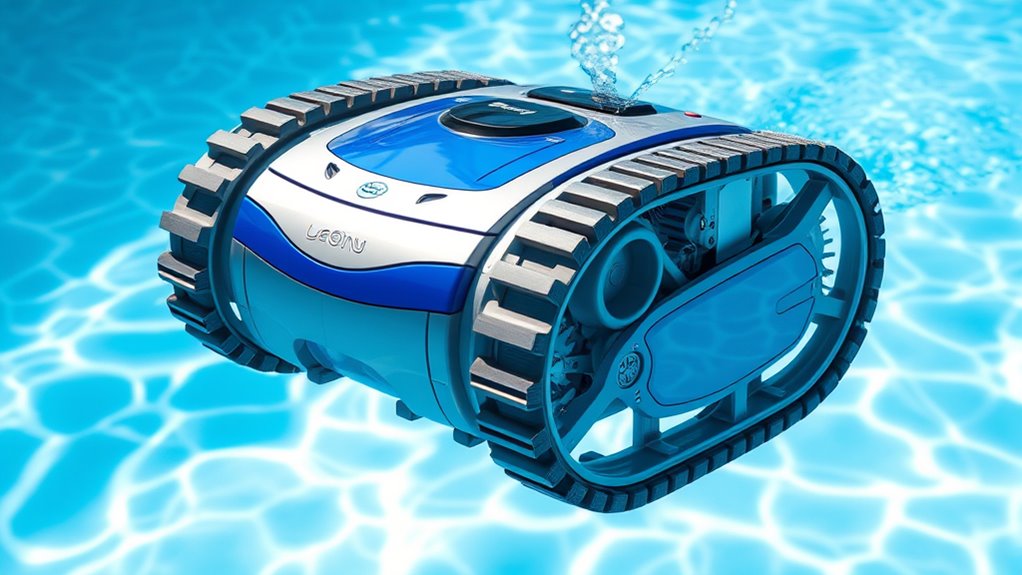
A robotic pool cleaner’s effectiveness relies on its carefully designed components working together seamlessly. The robotic pool cleaner components include a powerful motor, which drives its movement and cleaning brushes. These brushes scrub the pool surfaces, removing dirt and debris efficiently. The internal filters trap particles, ensuring cleaner water. Advanced pool cleaning technology often features sensors that detect obstacles and map the pool layout. The drive system, usually comprising wheels or tracks, enables smooth navigation across floors and walls. Additionally, a waterproof casing protects the electrical parts. Power is supplied either through an integrated cord or a rechargeable battery. Understanding robotic pool cleaner components can help users optimize maintenance and performance. Incorporating sensor technology enhances the cleaner’s ability to adapt to various pool shapes and conditions. The integration of filter systems ensures debris is effectively captured during cleaning cycles. Recognizing design features can further improve the overall efficiency and durability of the device. Glycolic acid benefits and the use of sensors and advanced technology in pool cleaners help optimize cleaning efficiency. All these pool cleaning technology elements work in harmony to deliver thorough, hands-free cleaning, making robotic pool cleaners effective and convenient tools for maintaining your pool’s cleanliness.
How Robotic Cleaners Navigate the Pool
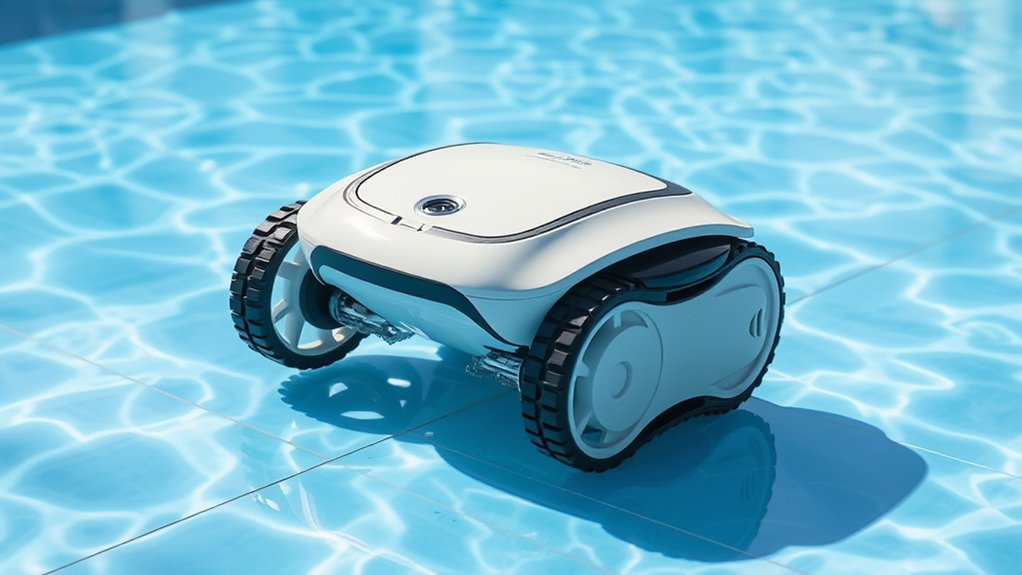
To effectively clean every corner of your pool, robotic cleaners use sophisticated wayfinding systems that detect obstacles and plan their path. These systems help guarantee thorough coverage while maintaining pool safety by avoiding collisions with ladders, skimmers, or pool walls. Many models employ sensors and algorithms that map out the pool’s layout, adapting their route for maximum efficiency. Maintaining proper chemical balance is vital, as it prevents algae buildup that could interfere with navigation sensors. Some cleaners also feature anti-tangle technology to prevent cords from wrapping around fixtures or drains. Additionally, sensor technology is continually advancing to improve obstacle detection and navigation accuracy. The integration of advanced sensors allows for even more precise mapping and obstacle avoidance, ensuring a comprehensive clean. Furthermore, navigation algorithms optimize the cleaner’s route, reducing cleaning time and energy consumption. By intelligently navigating your pool, these devices deliver a safer, more effective clean, reducing the need for manual intervention and helping you keep your pool in pristine condition. Robotics integration is projected to lower operational costs and improve maintenance efficiency over time. Moreover, incorporating smart technology enables remote monitoring and control, making pool maintenance more convenient for users.
Cleaning Mechanisms and Brushes
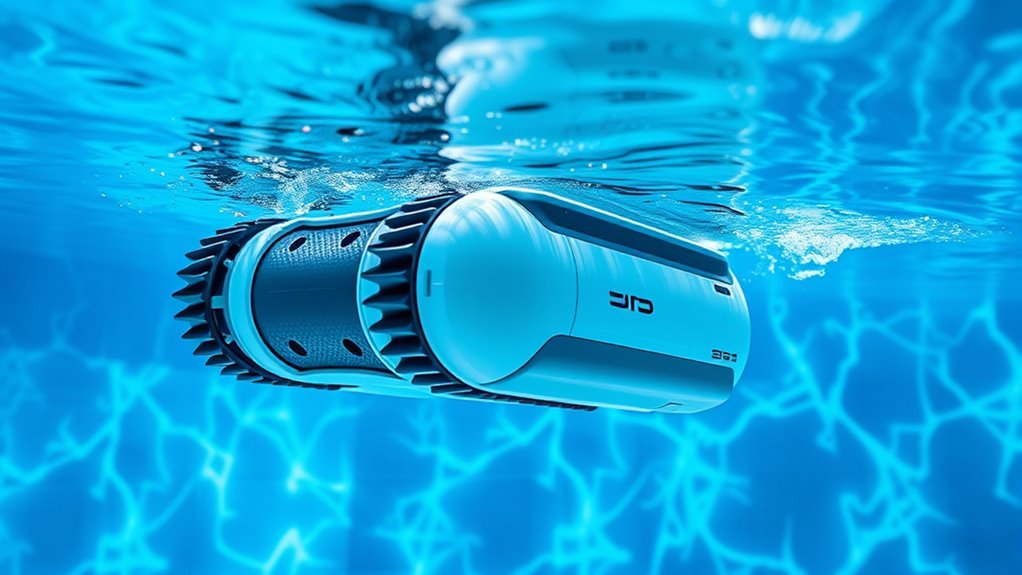
Robotic pool cleaners use a variety of bristle and scrubber systems to remove dirt and algae effectively. You’ll also find models with powerful suction and filtration mechanisms that trap debris as they work. Understanding how these cleaning components function helps you choose the right cleaner for your pool’s needs.
Bristle and Scrubber Systems
Bristle and scrubber systems are essential components that enable robotic pool cleaners to effectively remove dirt, algae, and debris from pool surfaces. Your cleaner’s bristle design influences how well it agitates stubborn grime, while the scrubber’s effectiveness depends on the material and motion. These brushes reach into corners and along surfaces, loosening debris for removal. Choosing the right bristle type guarantees thorough cleaning without damaging your pool’s finish. Here’s a quick comparison:
| Feature | Bristle Design | Scrubber Effectiveness | Maintenance Tip |
|---|---|---|---|
| Material | Nylon, rubber, or silicone | High for algae and dirt | Regularly rinse |
| Flexibility | Stiff or soft | Soft brushes for delicate surfaces | Replace when worn |
| Motion Type | Rotating or oscillating | Improves debris removal and coverage | Keep moving parts clean |
Additionally, using appropriate brush materials can help extend the lifespan of your cleaning system. Proper tuning of motors and brushes ensures optimal performance and longevity of the system. To maintain peak efficiency, it’s important to consider adjustments based on debris type, as different debris may require specific brush configurations. Regular inspection and cleaning of brushes also play a crucial role in keeping the system functioning at its best, preventing buildup that can reduce cleaning effectiveness.
Suction and Filtration
Have you ever wondered how robotic pool cleaners efficiently pick up dirt and debris? It all comes down to their suction and filtration systems. These cleaners use powerful suction motors to lift dirt from the pool floor and walls, trapping debris in fine filters or cartridges. Proper pool chemical balance helps these systems work more effectively, preventing algae buildup that can clog filters. Additionally, the type of pool liner impacts how well the cleaner moves and collects debris; smooth liners allow easier navigation, while textured or vinyl liners may require more precise suction settings. Regular maintenance of the filters ensures peak performance, keeping your pool spotless. Understanding the cleaning mechanisms and how brushes assist in debris removal can help you choose a robotic cleaner that handles your pool’s specific needs efficiently. Maintaining optimal filter performance is essential for consistent cleaning results and prolongs the lifespan of your robotic cleaner. Proper navigation technology enhances the cleaner’s ability to cover the entire pool surface thoroughly and efficiently. Regularly inspecting the suction system can prevent blockages that reduce overall cleaning efficiency. Additionally, ensuring the power source remains reliable is crucial for continuous operation and effective cleaning cycles.
The Role of Sensors and Mapping Technology
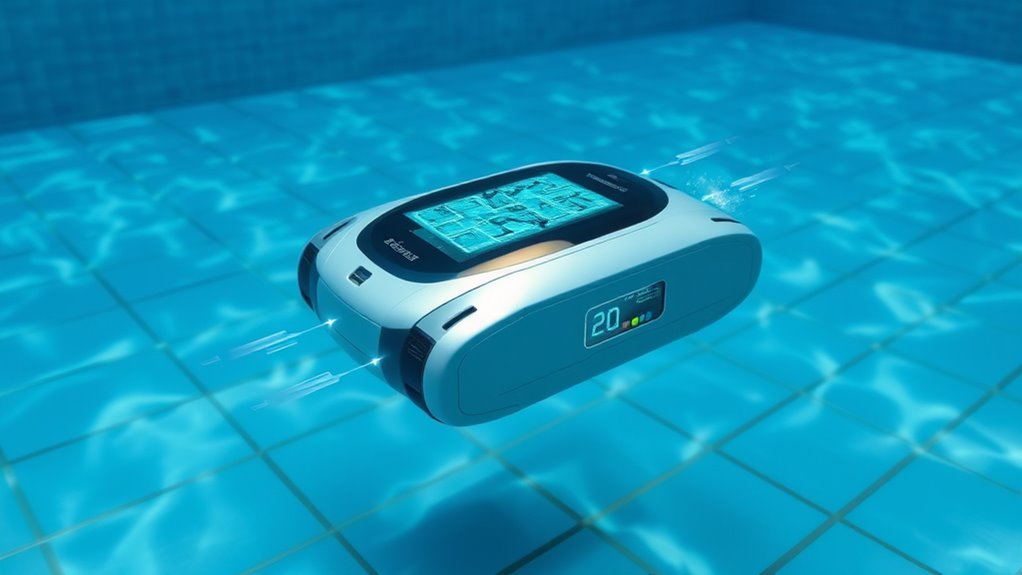
Sensors and mapping technology are the backbone of effective robotic pool cleaners, enabling them to navigate and clean efficiently. They use sensors to detect obstacles, walls, and water features, while mapping technology creates a virtual layout of your pool. Proper sensor calibration is essential for accurate detection, ensuring the cleaner doesn’t miss spots or get stuck. This precise mapping improves cleaning coverage and efficiency.
| Sensor Type | Function |
|---|---|
| Proximity Sensors | Detect obstacles and walls |
| Gyroscopes & Accelerometers | Track movement and orientation |
| Water Quality Sensors | Monitor debris and water clarity |
| Mapping Software | Generate accurate pool layouts |
With accurate mapping, your robotic cleaner covers every inch, making your pool spotless with minimal effort.
Power Sources and Battery Life
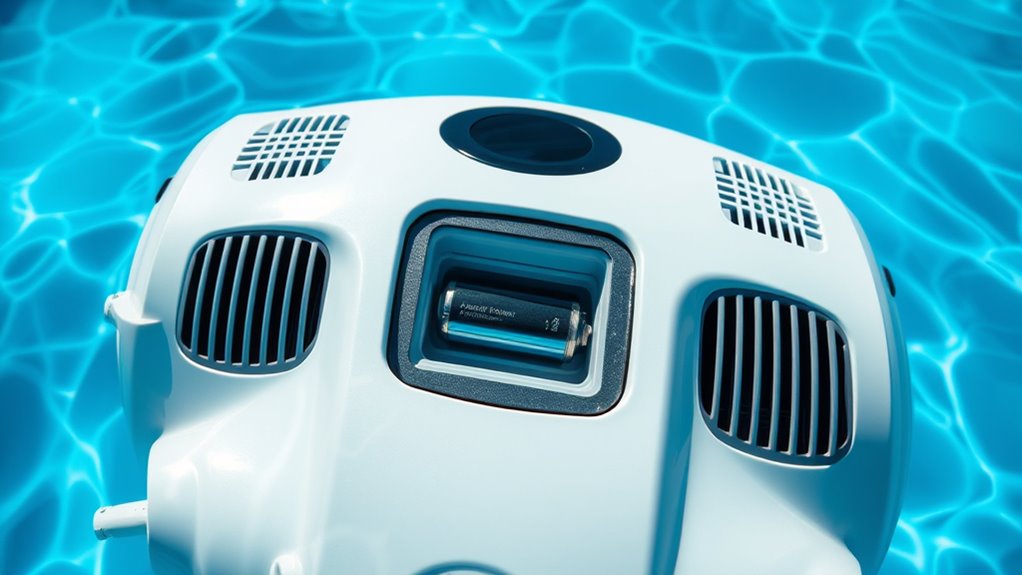
Robotic pool cleaners rely on their power sources to operate efficiently and complete thorough cleanings. Most models use rechargeable batteries, which influence both power efficiency and battery longevity. High-quality batteries ensure the cleaner runs longer between charges, allowing for more extensive coverage without interruption. Advanced models often feature lithium-ion batteries, known for their durability and faster charging times, helping you save time and energy. Proper maintenance, like regular charging cycles and avoiding complete discharges, can extend battery life. Some cleaners are equipped with energy-efficient motors that maximize runtime while minimizing power consumption. By choosing a model with optimized power sources, you guarantee your pool cleaner remains effective and reliable over time, reducing the need for frequent replacements and keeping your pool spotless with less hassle.
Water Filtration and Debris Collection
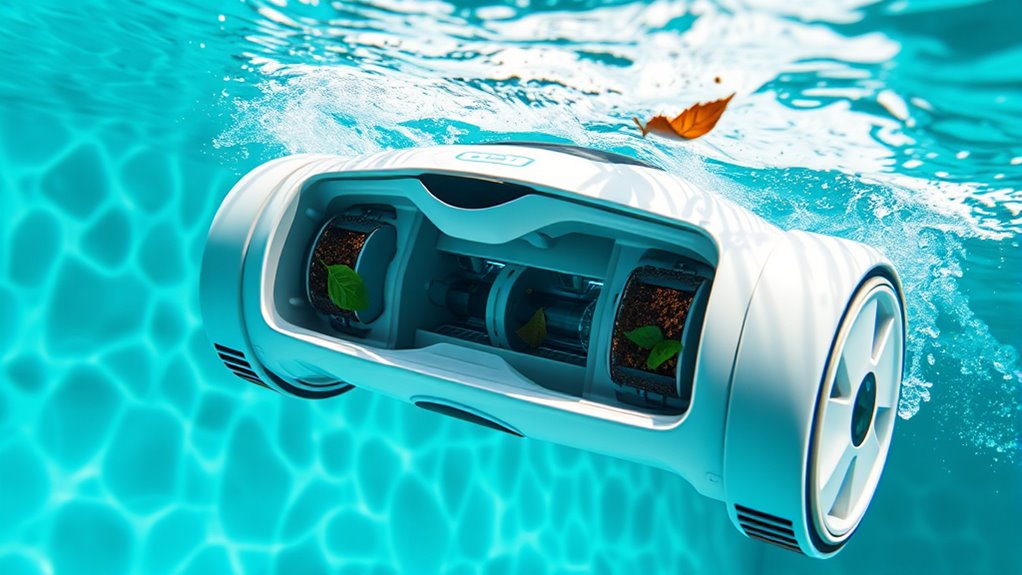
Robotic pool cleaners use advanced filtration systems to trap dirt and debris effectively. Their debris containers are designed for easy removal and minimal clogging, ensuring consistent cleaning. The water circulation process plays a key role in moving debris toward the filters, keeping your pool sparkling clean.
Filtration System Mechanics
A well-functioning filtration system is essential for keeping your pool clean and clear, as it actively removes dirt, debris, and impurities from the water. The system relies on filter media, such as fine mesh or cartridge filters, to trap particles as water flows through the cleaner. Water flow is carefully controlled by the cleaner’s pump and internal channels, ensuring that water passes through the filter media efficiently. This process captures dirt, algae, and other contaminants, preventing them from recirculating in your pool. The motor powers the water circulation, maintaining continuous filtration during cleaning cycles. A properly designed filtration system guarantees ideal water clarity while enabling the robotic cleaner to operate effectively, reducing your need for manual vacuuming and chemical treatments.
Debris Container Design
The debris container design plays a vital role in the overall effectiveness of your pool cleaner’s filtration process. A well-designed debris compartment ensures it can hold enough debris before needing to be emptied, which directly impacts cleaning efficiency. Larger filter capacity means you spend less time stopping to empty the debris compartment, allowing continuous operation. Look for a debris container that’s easy to access and clean, so maintenance doesn’t become a hassle. The shape and size of the debris compartment also influence how much debris it can hold without clogging or restricting water flow. A sturdy, well-sealed debris container prevents debris from escaping back into the pool, guaranteeing it’s effectively removed. Proper debris container design optimizes cleaning cycles and keeps your pool sparkling clean.
Water Circulation Process
Have you ever wondered how robotic pool cleaners guarantee your pool stays crystal clear? The water circulation process is key. These cleaners move efficiently through the water, using their filtration systems to trap dirt, debris, and algae, which helps maintain proper pool chemistry. As they circulate water, they draw debris into their debris containers, preventing clogs and ensuring the pool stays clean. Following safety guidelines, you should regularly check and empty the debris container and ensure the filter is clean. Proper water circulation also helps distribute chemicals evenly, supporting healthy pool chemistry. This process reduces the need for manual cleaning and keeps your pool water sparkling and safe for swimming. Understanding how the circulation works makes it easier to keep your pool in top condition.
Programming and Operating Modes
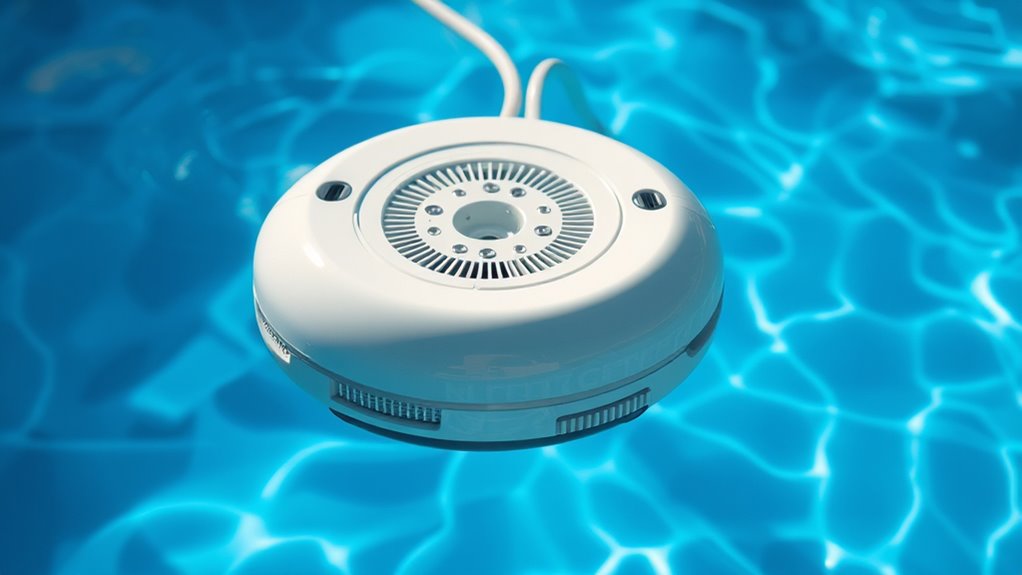
Understanding how to program and select operating modes is essential for maximizing your robotic pool cleaner’s efficiency. Most models feature user-friendly controls that utilize simple programming languages, allowing you to customize cleaning patterns and durations. You can set operating schedules to guarantee your pool is cleaned regularly without manual intervention, saving you time and effort. Many cleaners offer different modes, such as spot cleaning, full pool coverage, or specific zone targeting, giving you flexibility based on your pool’s needs. Some advanced models even allow remote programming via smartphone apps, enabling adjustments on the go. By mastering these settings, you ensure your cleaner operates at its best, maintains cleanliness, and extends its lifespan. Proper programming and scheduling help you get the most out of your investment.
Maintenance and Troubleshooting
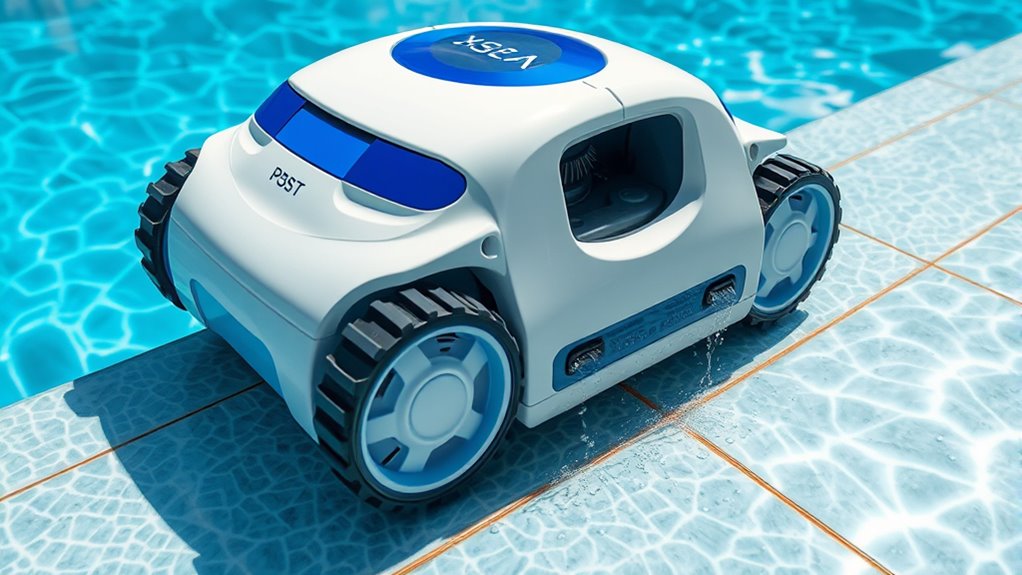
Regular maintenance keeps your robotic pool cleaner running smoothly and extends its lifespan. When issues arise, quick troubleshooting can save you time and frustration. Let’s explore some essential tips to keep your cleaner in top shape and resolve common problems efficiently.
Maintenance Tips for Robotic Cleaners
To keep your robotic pool cleaner functioning effectively, routine maintenance and troubleshooting are essential. Regularly check the filter and clean it to prevent clogs, especially after heavy use or debris accumulation. Monitor your pool’s chemical levels, as imbalances can affect the cleaner’s performance. Maintaining proper pool chemical balance ensures the robot’s brushes and sensors operate smoothly. Additionally, pay attention to water temperature; extreme temperatures can impact motor function and battery life. Store your robotic cleaner in a shaded, dry area when not in use, especially during off-season months. Inspect the power cord for wear or damage and test the unit periodically to catch issues early. Proper maintenance not only extends the life of your cleaner but also guarantees maximum cleaning efficiency.
Troubleshooting Common Issues
When your robotic pool cleaner isn’t working as it should, troubleshooting can quickly identify the problem and get it back in action. Start by checking for common issues like tangled cords or debris blocking sensors. Ensure your pool’s water is properly balanced; imbalanced chemicals can affect cleaning efficiency. Also, verify that your pool is safe for operation—no loose wires or hazards. Use the table below to diagnose issues quickly:
| Issue | Solution | Prevention |
|---|---|---|
| Robot not moving | Clean wheels and check for obstructions | Regularly inspect and clear debris |
| Poor cleaning coverage | Ensure sensors are clean and unobstructed | Maintain proper chemical balance |
| Not turning or charting | Reset the device and check for damage | Keep pool safe and free of hazards |
| Power issues | Check power source and connections | Use a dedicated outlet for safety |
| Stuck on stairs or corners | Manually free the robot and adjust settings | Regular maintenance and inspection |
Advantages of Using Robotic Pool Cleaners
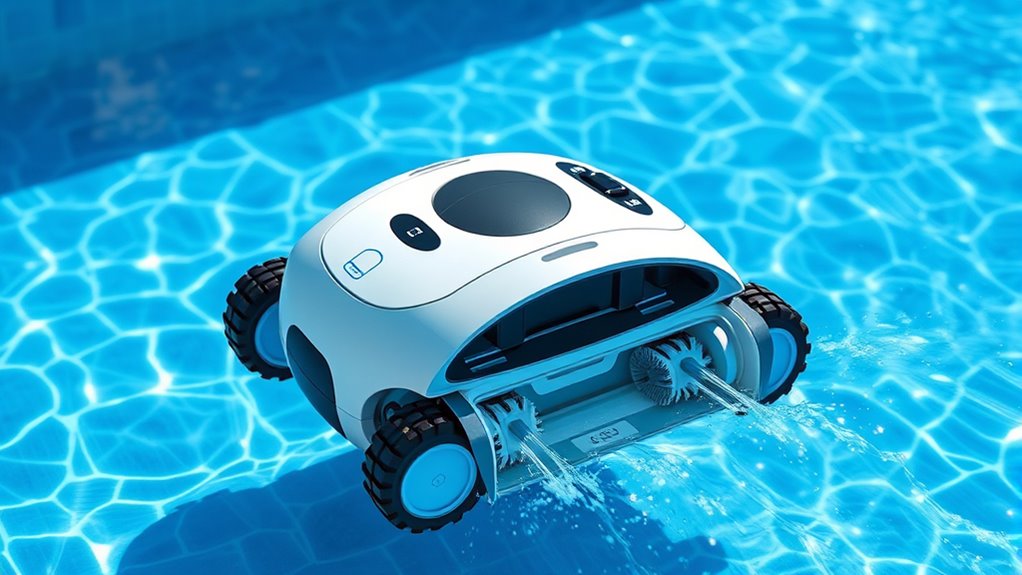
Robotic pool cleaners offer several advantages that make maintaining your pool easier and more efficient. They help keep your pool water balanced by thoroughly cleaning debris, which supports healthy pool chemistry. Regular use of a robotic cleaner reduces algae buildup and prevents the need for harsh chemical treatments. Additionally, these cleaners typically include features that improve pool lighting by removing dirt and algae from the water’s surface and walls, making your pool more inviting. They operate autonomously, saving you time and effort, and often come with programmable schedules for convenience. Plus, their precise cleaning capabilities ensure every inch of your pool is maintained, prolonging equipment lifespan and creating a safer swimming environment. Overall, robotic pool cleaners simplify upkeep while enhancing your pool’s appearance and safety.
Frequently Asked Questions
How Long Does a Typical Robotic Pool Cleaner Battery Last?
A typical robotic pool cleaner’s battery lifespan usually lasts about 2 to 3 years, but it depends on usage and maintenance. You can expect a recharge time of around 2 to 4 hours, which guarantees the cleaner is ready for its next session. To maximize battery life, avoid overcharging and store it properly. Regularly check the battery to ensure peak performance and extend its overall lifespan.
Can Robotic Pool Cleaners Work in All Pool Shapes and Sizes?
Think of your pool as a unique puzzle, and robotic cleaners as adaptable players. They can handle various pool shapes and sizes, but their cleaning efficiency depends on matching the right model to your pool surface. Some cleaners excel on flat surfaces, while others navigate complex corners. As long as you choose wisely, robotic pool cleaners work in most pool types, turning pool maintenance into a breeze.
Are Robotic Pool Cleaners Safe for Pool Liners and Tiles?
Robotic pool cleaners are generally safe for pool liners and tile surfaces if you choose the right model. They feature pool liner protection and tile surface safety measures that prevent damage during cleaning. Look for units with soft brushes and gentle suction to avoid scratches or tears. Regularly inspect your cleaner and keep it well-maintained to make sure it continues to protect your pool’s surfaces effectively.
How Often Should Robotic Pool Cleaners Be Maintained or Serviced?
You should follow a regular maintenance schedule for your robotic pool cleaner to keep it running smoothly. Typically, you’ll need to service it every 1 to 3 months, depending on usage and water conditions. Check the brushes, filters, and cables during each service, and clean or replace parts as needed. Staying consistent with your service frequency guarantees peak performance and prolongs your cleaner’s lifespan.
Do Robotic Pool Cleaners Require Wi-Fi or App Connectivity?
You might wonder if robotic pool cleaners need Wi-Fi connectivity or app integration. Many models do require Wi-Fi to connect to your smartphone, allowing you to control and schedule cleaning sessions easily through an app. This feature offers convenience, letting you start, stop, or monitor your cleaner remotely. However, not all models have these features, so check the product specifications if Wi-Fi connectivity or app integration is important to you.
Conclusion
Now that you know how robotic pool cleaners work, you’re well-equipped to keep your pool sparkling without breaking a sweat. These devices take the hassle out of cleaning, so you can enjoy your swim instead of scrubbing. Remember, a well-maintained cleaner saves you time and money in the long run—it’s a win-win situation. With the right care, your robotic helper will serve you well and keep your pool in tip-top shape, ensuring you stay ahead of the game.




